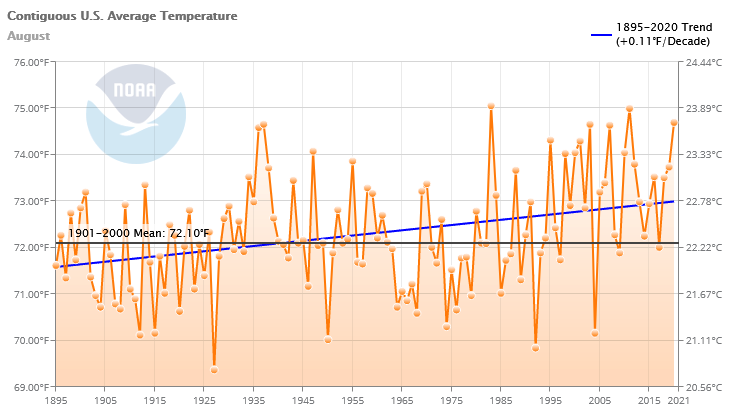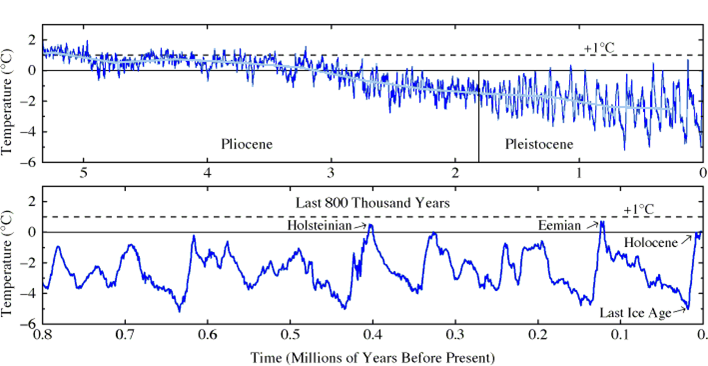Key Concepts
The long-term records of precipitation, temperature, wind, and all other aspects of the Earth's climate. Climate, like the Earth itself, has a history extending over several billion years. Climatic changes have occurred at time scales ranging from hundreds of millions of years to centuries and decades (Fig. 1). Processes in the atmosphere, oceans, cryosphere (snow cover, sea ice, continental ice sheets), biosphere, and lithosphere (such as plate tectonics and volcanic activity) and solar activity have caused these changes of climate.

The present climate, although changing, can be described as an ice-age climate, since large land surfaces are covered with ice sheets (for example, Antarctica and Greenland). The origins of the present ice age may be traced, at least in part, to the movement of the continental plates. With the gradual movement of Antarctica toward its present isolated polar position, ice sheets began to develop there about 30 million years ago. For the past several million years, the Antarctic ice sheet reached approximately its present size, and ice sheets appeared on the lands bordering the northern Atlantic Ocean. During the past million years of the current ice age, about 10 glacial-interglacial cycles have been documented. Changes in the Earth's orbital parameters, eccentricity, obliquity, and longitude of perihelion are thought to have initiated, or paced, these cycles through the associated small changes in the seasonal and latitudinal distribution of solar radiation. The most recent glacial period ended between about 15,000 and 6000 years ago with the rapid melting of the North American and European ice sheets and an associated rise in sea level, and the atmospheric concentration of carbon dioxide. See also: Greenhouse effect
The present interglacial climate reached its maximum warmth about 6000 years ago when, compared to the present, the high northern latitudes were slightly warmer, the northern continental interiors were drier, and the monsoon lands of Africa and southern Asia were wetter. These differences appear also to have been caused, at least in part, by differences in Earth's orbital parameters, compared to the present.
Changes of climate spanning centuries to decades occur within the more gradual changes just described. For example, the climate of northern Europe was slightly warmer about 1000 years ago than at present, but colder than at present 100 to 300 hundred years ago, when mountain glaciers advanced beyond present-day limits in Scandinavia and the Alps. The causes of these shorter-term changes of climate are not well understood, although volcanic activity, solar variability, and the internal dynamics of the atmosphere and ocean may all be involved. There is concern that human activities, such as massive deforestation and the burning of fossil fuels, are causing climatic change.
The climates of the distant geologic past were strongly influenced by the size and location of continents and by large changes in the composition of the atmosphere. For example, around 250 million years ago the continents were assembled into one supercontinent, Pangaea, producing significantly different climatic patterns than are seen today with widely distributed continents. In addition, based upon models of stellar evolution, it is hypothesized that the Sun's radiation has gradually increased by 10–20% over the past several billion years and, if so, this has contributed to a significant warming of the Earth. See also: Evolution of the continents; Paleoclimatology
Evidence
Instrumental records of climatic variables such as temperature and precipitation exist for the past 100 years (Fig. 1) in many locations and for as long as 200 years in a few locations. These records provide evidence of year-to-year and decade-to-decade variability, but they are completely inadequate for the study of century-to-century and longer-term variability. Even for the study of short-term climatic fluctuations, instrumental records are incomplete, because most observations are made from the continents (covering only 29% of the Earth's surface area). Aerological observations, which permit the study of atmospheric mass, momentum and energy budgets, and the statistical structure of the large-scale circulation, are available only since about the mid-1960s. Again there is a bias toward observations over the continents. It is only with the advent of satellites that global monitoring of the components of the Earth's radiation budget (clouds; planetary albedo, from which the net incoming solar radiation can be estimated; and the outgoing terrestrial radiation) became possible. See also: Meteorological satellites
There remain important gaps in the ability of climatologists to describe the present state of the climate. For example, precipitation estimates, especially over the oceans, are poor. Thus, although climatic changes are discernible from instrumental records, the task of defining the scope of these changes and diagnosing potential causes is difficult.
However, considerable evidence of climatic variations exists. For example, there is evidence of climatic warming in the polar regions of the Northern Hemisphere as well as from observed sea-level rise, global temperature rise, ocean warming, ocean acidification, and mountain glacier retreat. See also: Arctic sea-ice monitoring; Hydrological consequences of global warming; Ocean acidification; Tropical glacier monitoring
Evidence of climatic changes prior to instrumental records comes from a wide variety of sources. Caves, tree rings, and corals, as well as pollen and trace minerals retrieved from laminated lake sediments and ice sheets yield environmental records for past centuries and millennia. Advanced drilling techniques have made it possible to obtain long cores from ocean sediments that provide geologic records of climatic conditions going back hundreds of millions of years (Fig. 2). See also: Dendrochronology; Caves and climate change; Geologic history of reefs; Geologic time scale; Palynology

Causes
Many extraterrestrial and terrestrial processes have been hypothesized to be possible causes of climatic fluctuations. These include solar irradiance, variations in orbital parameters, motions of the lithosphere, volcanic activity, internal variations of the climate system, and human activities. It is likely that all of the natural processes have played a role in past climatic changes. Also, the climatic response to some particular causal process may depend on the initial climatic state, which in turn depends upon previous climatic states because of the long time constants of lithosphere, oceans, and cryosphere. True equilibrium climates may not exist, and the climate system may be in a continual state of adjustment.
Solar irradiance
Variations in solar irradiance would almost certainly have an influence on climate. In addition to the possible long-term evolution of the Sun, the changing appearance of the Sun, the so-called sunspots, hint at shorter-term variability on the scale of years to centuries. Satellite observations have detected decadal-scale fluctuations in solar radiation on the order of 0.1%. Radiance variability in limited portions of the solar spectrum has also been observed but has not been linked clearly to climate variability. See also: Solar radiation
Orbital parameters
Variations of the Earth's orbital parameters (eccentricity of orbit about the Sun, longitude of perihelion, and inclination or tilt of the rotational axis) lead to small but significant variations in incoming solar radiation with regard to seasonal partitioning and latitudinal distribution. These variations occur at times scales of 20,000 to 100,000 years and have been linked to glacial-interglacial cycles and sedimentation cycles in geologic records. See also: Earth rotation and orbital motion
Lithosphere motions
Sea-floor spreading and continental drift, continental uplift, and mountain building operate over long time scales and are almost certainly important factors in long-term climate. See also: Continental drift; Marine geology; Orogeny; Plate tectonics
Volcanic activity
Volcanic activity produces gaseous and particulate emissions that lead to the formation of persistent stratospheric aerosol layers. It may be a factor in climatic variations at all time scales. See also: Volcano
Internal variability of climate system
Components of the climate system (atmosphere, ocean, cryosphere, biosphere, land surface) are interrelated through a variety of feedback processes operating over a wide range of time scales. These processes could, in principle, produce fluctuations of sufficient magnitude and variability to explain any observed climatic change. For example, atmosphere-ocean interactions may operate over time scales up to centuries, the basic period of overturning of the ocean thermohaline circulation; and atmosphere-ocean-cryosphere interactions may operate over time scales up to tens of millennia, the time required to build a major ice sheet. Several hypotheses have been proposed to explain glacial-interglacial fluctuations as complex internal feedbacks among atmosphere, ocean, and cryosphere. (Periodic buildup and surges of the Antarctic ice sheet and periodic fluctuation in sea ice extent and deep-ocean circulation provide examples.) Atmosphere-ocean interaction is being studied intensively as a possible cause of short-term climatic variations. It has been observed that anomalous ocean temperature patterns (both equatorial and midlatitude) are often associated with anomalous atmospheric circulation patterns. Although atmospheric circulation plays a dominant role in establishing a particular ocean temperature pattern (by means of changes in wind-driven currents, upwelling, radiation exchange, evaporation, and so on), the anomalous ocean temperature distribution may then persist for months, seasons, or longer intervals of time because of the large heat capacity of the oceans. These anomalous oceanic heat sources and sinks may, in turn, produce anomalous atmospheric motions. The Earth's biosphere may also be actively involved in climatic changes. For example, the atmospheric concentration of carbon dioxide is linked to the carbon reservoirs of the continents and oceans via photosynthesis-respiration cycles, and gas exchange at the air-ocean interface. See also: Atmospheric general circulation; Biosphere; Ocean circulation
Human activities
Forest clearing and other large-scale changes in land use, changes in aerosol loading, and the changing concentration of carbon dioxide in the atmosphere are examples of mechanisms through which human activities influence the large-scale climate. See also: Aerosol-climate interactions; Air pollution; Climate modification; Deforestation
Modeling
Because of the complexity of the real climate system, numerical models of climate are being used to study particular processes and interactions. Some models treat only the global-average conditions, whereas others, particularly the dynamical atmosphere and ocean models, simulate detailed patterns of climate. These models are of great importance in for understanding climatic processes and assessing the effects of human activities on climate. See also: Climate modeling; Climatic prediction; Climatology





